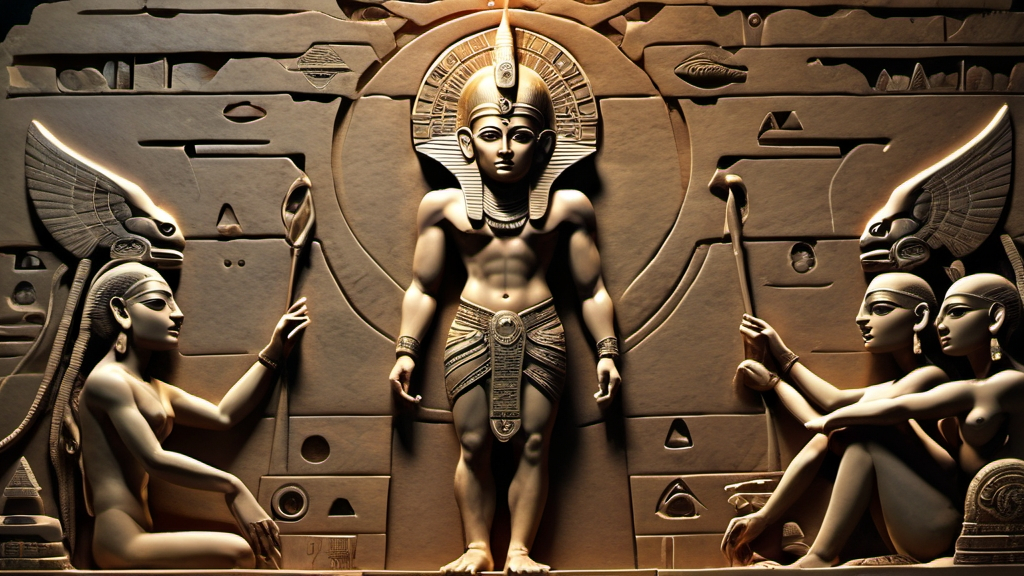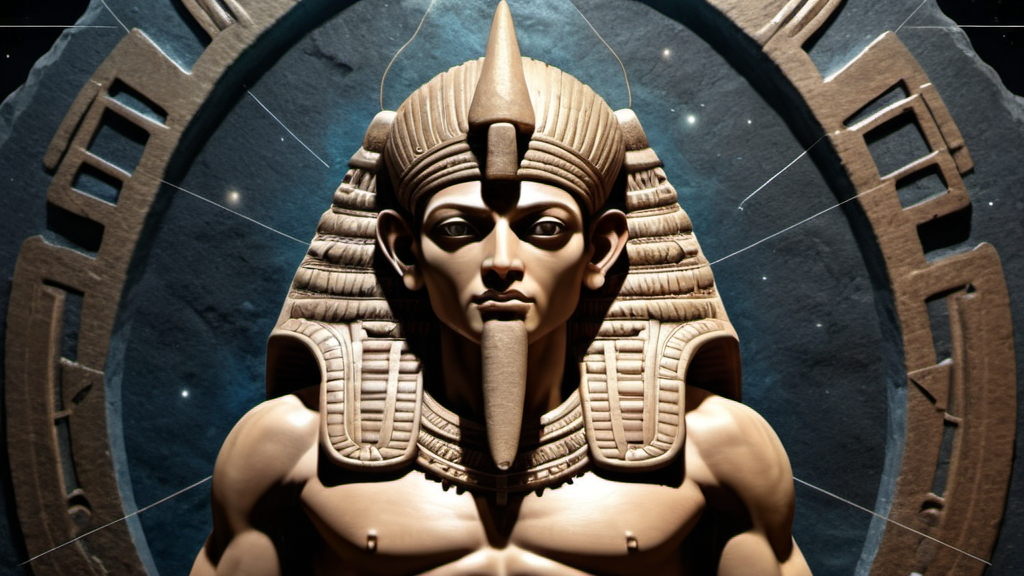Understanding the Anunnaki’s significant role in human history is essential.

1. Introduction
Anunnaki is a group of deities of ancient Mesopotamia. They are the children of Anu and Ki, brother and sister gods, themselves the children of Anshar and Kishar who in turn were the children of Lahamu and Lahmu. According to later Assyrian and Babylonian myth, the Anunnaki were the children of Anu and Ki, brother and sister gods, themselves the children of Anshar and Kishar. This has also been the case in a lot of modern research. The basic structure of gods is seen as a direct analogy to the social strata of Sumerian civilization, with Anu being the equivalent to the land, Ki the equivalent to the farmers, Enlil the storm god the equivalent to the farmers overseer, and so on.
The name is variously written “a-nuna”, “a-nuna-ke-ne”, or “a-nun-na”, meaning “princely offspring” or “offspring of Anu”. According to The Oxford Companion to World Mythology, the Anunnaki are the Sumerian deities of the old primordial line; a group of gods, not the clan of any one god. They are overthrown and replaced in the Epic of Creation; however, they are not the enemies of the new gods, and the Anunnaki gods who are mentioned in the Epic are always said to be the superior ones.
2. The Origins of the Anunnaki
Before we can delve into what the Anunnaki actually did on Earth, we must first carefully consider what they were originally, where they were from, and what they were doing before they came here. According to ancient Mesopotamian mythology, the Anunnaki were the children of Anu and Ki, brother and sister gods, themselves the children of Anshar and Kishar, who in turn were the children of Lahamu and Lahmu, the very first gods mentioned in the Babylonian creation epic.
Lahmu and Lahamu, in turn, were the children of Tiamat and Abzu, who were in effect the personifications of the saltwater and freshwater, essentially life-giving essences to the peoples of the time. Anu was the god of the sky, and held the highest position in the Sumerian pantheon. Later his position was taken by Enlil, and the two gods are frequently confused with one another. Ki was originally a goddess of the earth, but the name came to be used for the earth itself, and it was said that she was the earth’s physical form. Anu and Ki were inextricably intertwined to the workings of the cosmos, and it was through their union that the Anunnaki were born.
In this, the mythology reflects ancient Mesopotamian cosmology, wherein it was believed the movements of the planets and stars affected everything in the world, especially human fate. Anu became the god of the planet Uranus, and Ki the goddess of the earth-moon. This may seem like nothing extraordinary, but it was the belief of the ancient Sumerians that these entities were not merely planets or stars as we think of them, but conscious deity-beings, and that Anu and Ki were, in fact, the actual ruling king and queen of the universe.
2.1. Mythological Accounts
Several sources have an Anunnaki creation story, which is presumed to be the original. What follows is a summary, in my own words, of the Anunnaki story. Anu, the father of the Anunnaki, came to Earth from a perfected civilization located on another planet in our solar system, that the Sumerians called Nibiru. His arrival on Earth was not the beginning of man, but the state of man as we know it, and the beginning of the Anunnaki’s involvement in our development.
Oh, how this makes more plausible the belief that we were genetically engineered by the Anunnaki, and adds to the weight that the Nibiru theory could quite possibly be true. Upon Anu’s arrival on Earth, he found that his sons, Enlil and Enki, who were to share rule over Earth, had not completed several tasks assigned to them. At this point, it is unclear as to how man was created, but several ancient texts depict Enki and Enlil as differentiating peoples. Enlil was the more rash, punitive one, and Enki the more creative and intellectual. This has led to beliefs that there were two creations of man, one by Enki, and one by Enlil, that were very different from one another.
2.2. Ancient Texts and Artifacts
In the fourth millennium, legend credits the god Thoth in Egypt, Quetzlcoatl in Mexico, Hermes in Greece, Viracochas in Peru with bringing the same emancipation to the savage peoples they instructed. These cultural bringers were no doubt the humanoid servants used by the Anunnaki to till and toil for them. The mystery of the sudden appearance of Homo sapiens, fully developed, can be explained by the Anunnaki giving up their laborious work and creating the first modern man “Lu-mach” to do the toilsome labor for them. It is a coincidence the Sumerian texts mirror the Genesis account of man’s creation in the Gods’ image, living in a paradise garden.
Approximately 4,000 years ago, the Anunnaki visited Earth from a planet called Nibiru. The first six of the “Meso-Four”, or the first 6 of the Mesopotamian Gods, were Anu, Enlil, Enki, Ninhursag, Nanna, and Utu. Many other gods were said to be children of the primary deities. These primary deities were known as “The Siblings” in which Enlil held authority over the other Siblings. Enlil’s brothers and sister sat in grand councils to make decisions, and Enlil was the final say as “Chieftain of the Gods”. His brother Enki, who is also known as Ea by the Akkadians and Babylonians, has also been recognized as the Poseidon from ancient Greek mythology. Ea was a leading researcher and was in charge of creating a worker being to do the toilsome labor that the Anunnaki no longer wished to do. In the early years of the Anunnaki being on Earth, it was only the Astronaut Corps who made the trips to Earth, arriving at our gold mines in southeast Africa.

3. The Role of the Anunnaki in Human History
From here, the Anunnaki concentrated in the region of Mesopotamia, where the first known and recorded civilization was formed. Sumer, an empire built by the Anunnaki in an attempt to create a civilization of humans that would do their bidding, an empire with consecutive Kings and a method of control of the workers and resources of Earth. This knowledge comes from various archaeological sites in Mesopotamia, but most importantly evidence comes from the Sumerians themselves with the existence of over 20,000 clay tablets displaying their recorded history and beliefs, some of these written on behalf of the Anunnaki Lords themselves.
The reason the Anunnaki are so significant to human history is their impact on human civilization. By creating a slave race, obtained from the most advanced primates on Earth at the time (possibly early Homo sapiens), they were able to do what they wished with the resources of our planet. It is for this reason that the creation of humankind and the need for the working and thinking capabilities of our race, the Anunnaki are most known for. The creation of Homo sapiens is said to take place around 200,000 years ago. The Anunnaki had thought to enslave primitive workers to mine gold in Africa. The time span from then until around 100,000 years ago and the further genetic manipulation of humankind and fusion with Anunnaki genes and creatures from Earth has led to the more advanced genes of modern humans, i.e. finding the missing link.
3.1. Creation of Homo Sapiens
The explanation of how the Anunnaki ‘gods’ created Homo sapiens is detailed in ancient texts, most notably in a Sumerian myth which is now considered to be the story of Genesis found in the Old Testament. The god of that myth is Enlil, ‘Lord of the Command’, and is a dictator. He suggests to the Anunnaki that, to make life easier, they should create a servant being to do their work. After much toil, they were instructed by Enki, Enlil’s brother, to genetically alter the existing hairy hominid and fashion Homo sapiens.
The result was the birth of the Adamu, a hybrid being which was able to reproduce. This created a problem for the Anunnaki as the new species began to grow and take more control of the earth, eventually forming cities and societies. Enlil was vehemently against this and repeatedly tried to have an all-out war wipe out humanity before finally bringing about a great flood to destroy them all. This flood and the story surrounding it can be found in many ancient cultures and religions.
3.2. Genetic Manipulation and Civilization Building
The text above corresponds with the creation of modern man in the sense of genetic manipulation. It truly does make you wonder just how modern man came to be, as it is scientifically and historically proven that modern man has suddenly “appeared” far too fast in terms of evolution and shows many “missing links”. I’ve heard shocking comments from many academic professors today excluding the idea of evolution for mankind, as they see that the evidence doesn’t stack up and it almost seems as though modern man was placed on this earth.
In some cultures, it is almost common knowledge that human beings were created by higher beings who are referred to as gods. This ties in with the Anunnaki and the creation of modern man through genetic manipulation. Following this, man was taught to be civilized and was given knowledge from the Anunnaki. The idea of gods walking among us and the signs of mankind being taught and guided is evident not just through this text but in ancient cultures around the world, which I will write about in section 3.3.
It is known that the Anunnaki had genetically planned for their Homo sapien “Talking Ape” species to be a slave race. The sudden leaping in progress for the human race suggested that this is the case. The age-old questions of “What are we” and “Why are we here” didn’t simply appear overnight. These are genetic memories that have been passed down to us from the time of genetic engineering.
3.3. Influence on Ancient Cultures and Religions
The Anunnaki were worshipped by various names and had many myths and legends surrounding them. Many of these stories are strikingly similar, while incorporating a specific cultural stamp reflecting that people’s interpretation of the Anunnaki according to their own experience. Often, the gods were seen as capricious beings, given to squabbling among themselves and resorting to deception and treachery to get their own way. Yet at the same time, the gods were also responsible for teaching mankind the necessities of civilization, as well as instituting kingship. In many of the cultures, the god who created mankind and appointed the king was viewed as the very same being. In ancient Sumer, the word Anunnaki translated directly as “those who from heaven to earth came”, perhaps a clue to their otherworldly nature. But for the people of the time, the Anunnaki were not otherworldly gods; they were residents of earth.
4. Modern Interpretations and Controversies
In the 1970s, Erich von Däniken published his book “Chariots of the Gods?” which became an immediate bestseller. In this book, Däniken put forth the hypothesis that the Anunnaki were a race of extraterrestrial beings who were mistaken for gods by human beings. According to Däniken, the Anunnaki were responsible for the ancient astronaut theory. Däniken states that these ancient beings were believed to have helped build the great pyramids of Egypt and other ancient ruins.
This theory generally aligns with the perspective of those who believe in ancient astronauts or the “paleocontact” hypothesis. Supporters of this theory point to numerous myths and legends from around the world in their attempt to support their ideas. In their interpretation, various mythical accounts are representative of extraterrestrial intervention. One such example is the so-called “myth of Adapa”. In this myth, the sage and ruler of Eridu, Adapa, whose father was the God of Wind, breaks the wing of the South Wind, which inexplicably resulted in his being summoned to the court of Anu, the king of the gods.
4.1. Ancient Aliens Theory
In 1976, author Zecharia Sitchin released his first book, The 12th Planet, claiming that he has discovered evidence in ancient texts that are thousands of years old, that point to an ancient race of aliens from a planet called Nibiru. In his opinion, Nibiru has an elongated orbit which comes close to Earth every 3,600 years. Sitchin believed that beings from Nibiru came to Earth and genetically modified ancient humans to be used as a slave species to mine gold. These beings were known as the Anunnaki, from the Sumerian myths. Broadcasted in 2009, the Ancient Aliens series has become popular and features A.A.T. Supporters base a large portion of today’s knowledge on the subject from this show and a number of websites. Not all data is correct, and being an interpretive theory, it is impossible to distinguish between correct and incorrect information. Due to this, there is often conflicting material, therefore it is important to base conclusions on data taken directly from ancient texts.
4.2. Skeptical Perspectives
Hence, it’s important to understand the Ancient Astronaut theory as just a modern representation of an already existing belief that the Anunnaki had once been formative influences on our culture. Yet, this idea involves an overlap of theories involving the ancient aliens’ contacts with various other prehistoric and ancient Earth civilizations, on which the Anunnaki stories are not always necessarily definitive. Due to this, interpretations of the Anunnaki as simply having been yet another ancient alien race in the wealth of possibilities are seen as too speculative.
The theory that the Anunnaki were not mythical gods, but rather successful leaders of an advanced alien civilization, is one that has not been agreed upon by all. This idea does not “separate” the ancient alien theory from the one of the Anunnaki, as it is a common understanding that many extraterrestrial life forms in the Ancient Astronaut theories have been from the planet Nibiru, i.e. one Anunnaki leader, Anu’s intended departure from the planet to Earth led to a permanent colony being established here. Despite this, views that only the Anunnaki leaders had come and that they had then begun a series of genetic modifications to us, replacing existing creatures already living here (i.e. Homo erectus) with a servant race of human slave workers, especially mimic the biblical story of man’s creation and the involvement of God and his angels in mankind’s history.
4.3. Impact on Popular Culture
The idea of ancient alien visitors has had a great effect on the global. The show “Ancient Aliens” has received much popularity and although being labelled as inauthentic and purely speculative, the impact of claims made in such TV shows has a subtle yet impactful effect on public opinions. The internet meme culture has also referenced the Anunnaki with notions of a Nibiru apocalypse and reptilian conspiracy theories.
It is difficult to measure the overall impact on the global culture; however, in American culture, “The Day the Earth Stood Still,” “Close Encounters of the Third Kind,” and “Stargate” are three examples of many movies and TV shows that have drawn upon ancient astronaut themes. Although there is no direct evidence that these were influenced by the Ancient Astronaut theories, the general concept of ancient astronauts has been highly influential on science fiction. This is also evident in the video game industry, with many popular games sharing science fiction themes and also drawing upon Sitchin’s Ancient Astronaut Hypothesis and the Nibiruan Anunnaki.
References:
Hammer, O. and Swartz, K. “Ancient Aliens.” Handbook of UFO Religions, 2021. [HTML]
Alamineh, Gubaye Assaye, et al. “The negative cultural impact of tourism and its implication on sustainable development in Amhara Regional State.” Cogent Arts & Humanities 10.1 (2023): 2224597. tandfonline.com
Darma Putra, I. Nyoman, et al. “Affinity tourism and exotic tourism in Bali. The Chinese and Indian tourist gaze in the Garuda Wisnu Kencana Park.” Journal of Tourism and Cultural Change 19.4 (2021): 427-443. tandfonline.com
Allam, Z., Sharifi, A., Bibri, S. E., Jones, D. S., and Krogstie, J. “The metaverse as a virtual form of smart cities: Opportunities and challenges for environmental, economic, and social sustainability in urban futures.” Smart Cities, 2022. mdpi.com
Wright, D. W. M. “Encountering UFOs and aliens in the tourism industry.” Journal of Tourism Futures, 2022. emerald.com
Wang, Wanfei, et al. “Independent travelers’ niche hotel booking motivations: the emergence of a hybrid cultural society.” International Journal of Hospitality Management 89 (2020): 102573. gre.ac.uk
Frame, Bob, et al. “Tourism and heritage in Antarctica: exploring cultural, natural and subliminal experiences.” Polar Geography 45.1 (2022): 37-57. tandfonline.com
Hendry, J. “The Orient strikes back: A global view of cultural display.” 2020. [HTML]
Hartley, J., Ibrus, I., and Ojamaa, M. “On the digital semiosphere: Culture, media and science for the Anthropocene.” 2020. [HTML]
Sobirov, Bakhtiyorovich Umid. “The necessity of ziyarah tourism in the spiritual perfection of people.” Asian Journal of Multidimensional Research (AJMR) 9.7 (2020): 85-88. [HTML]








Connect me